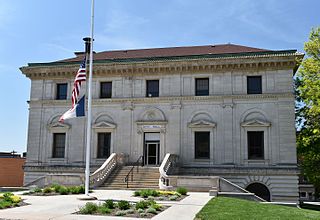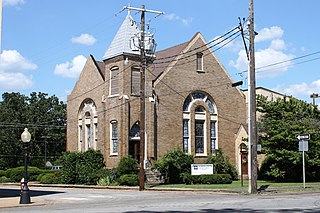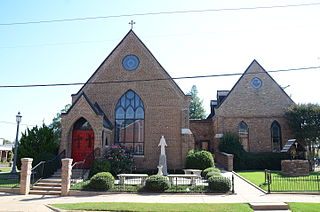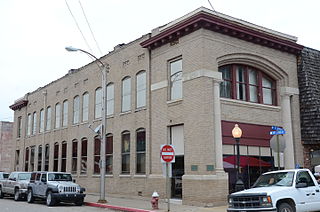
The Columbia County Courthouse is located at Court Square in the heart of Magnolia, the county seat of Columbia County, Arkansas. The two-story brick and stone structure was designed W. W. Hall and built in 1905. It features Renaissance Revival styling, with Corinthian pilasters separating the windows on the second level and a projecting Greek temple portico with recessed entries under round arches on the first level, and fluted Corinthian columns on the second.

The Elbert P. Tuttle U.S. Court of Appeals Building, also known as U.S. Post Office and Courthouse, is a historic Renaissance Revival style courthouse located in the Fairlie-Poplar district of Downtown Atlanta in Fulton County, Georgia. It is the courthouse for the United States Court of Appeals for the Eleventh Circuit.

The United States Customhouse is a historic custom house located at Houston in Harris County, Texas.

The Little Rock U.S. Post Office and Courthouse, also known as Old Post Office and Courthouse, in Little Rock, Arkansas, is a historic post office, federal office, and courthouse building located at Little Rock in Pulaski County, Arkansas. It is a courthouse for the United States District Court for the Eastern District of Arkansas.

Ottumwa City Hall is the official seat of government for the city of Ottumwa, Iowa, United States. The building originally served as a post office and federal courthouse. It is part of the Central Park area, which includes: Ottumwa Public Library, Wapello County Courthouse and St. Mary of the Visitation Catholic Church. The building was listed on the National Register of Historic Places in 1976.

The Cumberland Presbyterian Church is a historic church at the junction of Race and Spring Streets in Searcy, Arkansas. It is a single-story buff brick Romanesque Revival structure, with a cross-gable roof configuration and a square tower at the right front corner. The tower houses the main entrance in a pointed-arch recess, and has a louvered belfry at the second level below the pyramidal roof. The church was built in 1903 for a congregation organized in 1824, and is a fine example of Romanesque and Classical Revival architecture.

Trinity Episcopal Church is a historic church at the junction of North Elm and Market Streets in Searcy, Arkansas. It is a single story brick building, built in the English parish church style in 1902, and is joined by a small connector to a 1935 parish house of similar construction. It is the only church of this style in White County. Its main facade has buttressed corners, and a large lancet-arched window at the center, with the main entrance set recessed in a projecting gabled section to its left.

The Bank of Searcy is a historic bank building at 301 North Spruce Street in downtown Searcy, Arkansas. It is a two-story buff brick structure, whose main entrance is flanked by Doric columns supporting a segmented arch. The building has other vernacular elements of the Classical Revival, including segmented-arch window bays on the facade facing Arch Avenue. It was built in 1906, following a fire that destroyed many of the commercial buildings on the west side of the courthouse, which stands across North Spruce Street.

The Brooks House is a historic house at 704 East Market Street in Searcy, Arkansas. It is a 1 1⁄2-story wood-frame structure, with a side-gable roof, and a slightly off-center projecting gabled section, from which an entrance vestibule projects further at its left edge. To the left of the projecting section is a segmented-arch dormer over a group of three sash windows. Built about 1935, it is a fine local example of a modest English Revival house, echoing more elaborate and larger-scale homes of the style in wealthier communities.

The Bank of Marshall Building is a historic commercial building at the southeast corner of Main and Center Streets in downtown Marshall, Arkansas. It is a 1 1⁄2-story brick masonry structure, built in 1913-14 by Jasper Treece, a local builder, in a vernacular Colonial Revival style. Its front facade is three bays wide, with an arched window bay to the left of the central entrance, and a square window bay to the right. A narrow band of windows is set in the half story, highlighted by bands of stone acting as sills and lintels. The bank, established in 1914, and apparently failed during the Great Depression.

The Campbell Post Office–Kuykendall General Store is a historic residential–commercial building in rural Searcy County, Arkansas. It is located on County Road 73, northwest of Oxley, Arkansas. It is a single-story wood frame structure with modest Greek Revival styling. Its construction date was long thought to be 1920, but it was more likely built around 1900, still an extremely late date for the Greek Revival. It was converted into a post office and general store in the 1920s by Henry Kuykendall.

The Dugger and Schultz Millinery Store Building was a historic commercial building at the southwest corner of Glade and Nome Streets in Marshall, Arkansas. It was a single-story structure, built out of rusticated stone in the style typical of the Ozark Mountains. The rounded-arch openings of the facade, the entrance recessed in the rightmost, gave the building a Romanesque Revival flavor. It was built in 1905 by Frazier Ashley, a local stonemason, and initially housed a hatmaker's shop.

The Farmers Bank Building is a historic commercial building at Main and Walnut Streets in Leslie, Arkansas. It is a single-story brick structure, with its entrance angled at the street corner. The main facade is three bays wide, all with round arches trimmed in limestone. Built about 1910, this Romanesque Revival building house the Farmers Bank until it failed in the 1930s, and then the local post office for a time.

Pattie Cobb Hall, is an historic academic building on the campus of Harding University in Searcy, Arkansas. It is a large three-story Colonial Revival structure, built out of reinforced concrete faced in brick. Its flat roof is encircled by a low balustrade, and a four-column portico projects from the front. The hall was built in 1919, and is one of two buildings surviving from the time when this campus was home to Galloway Female College. That school closed in 1933, and its campus was purchased by Harding the following year.

The Old Post Office is a historic former post office building on Convention Boulevard in Hot Springs, Arkansas. It is a steel and masonry structure, two stories in height, finished in brick and stone, with Renaissance Revival styling. Its main facade is five bays wide, with a center entrance set in a round-arch entrance with an elaborate keystone. The interior lobby area has its original red marble finish, with quartersawn oak trim. The former post office was built in 1901, and is one of the city's best examples of Renaissance Revival architecture.

The Mayfair Hotel is a historic building at Spring and Center Streets in Searcy, Arkansas. It is an L-shaped two story brick building, with Spanish Revival styling. It has a hip roof with stepped wall dormers and exposed rafter ends in the eaves, and a corner tower with a similar stepped parapet. Built in 1924, it is the only historically non-residential Spanish Revival building in White County. It has been converted into a multiunit apartment house.

The Robertson Drugstore is a historic commercial building at Spring Street and Arch Avenue in central Searcy, Arkansas. It is a two-story brick structure with basically vernacular style. It was built about 1860, and is the city's only commercial building to survive from the pre-Civil War period. It was the home to the city's first drugstore, and is the oldest commercial building in White County.

The Dalton Woodson House is a historic house at 107 West Arch Avenue in Searcy, Arkansas. It is a single-story brick building, in a picturesque interpretation of English Revival architecture. It is a side gable roof that extends across a porte-cochere with an arched opening, set next to a similar arched opening providing access to a recessed secondary entry. A cross gable extends across the centers of these two arches, and there is a smaller and steeper arch above the main entrance, which is set between the right arch and a chimney with stepped stone shoulders. The house was built in 1929, and is one of the city's finest examples of English Revival architecture.

U.S. Post Office is a historic post office building located at Carrollton, Carroll County, Missouri. It was designed by the Office of the Supervising Architect under James Knox Taylor and built between 1910 and 1912. It is a two-story, rectangular, Renaissance Revival style building constructed of regular coursed, smooth cut, Missouri limestone. It has a low hipped roof of red tile and features two large round arched windows flanking the main entrance.

The Jonesboro U.S. Post Office and Courthouse is a former federal building located at 524 South Church Street, in downtown Jonesboro, Arkansas. It is a three-story masonry structure, built out of brick and limestone. The ground floor is visually presented as a basement level clad in red brick, while the upper levels are finished in stucco with brick trim. Although the building lacks rounded-arch openings normally found in the Renaissance Revival, it is laid out along lines typical of that style, with the courtrooms on the second floor in the piano nobile style. The building was built as a courthouse and post office in 1911-13 to a design by James Knox Taylor, the Supervising Architect of the United States Treasury. It was used as a federal courthouse until 1977, and has seen a variety of commercial uses since then.






















